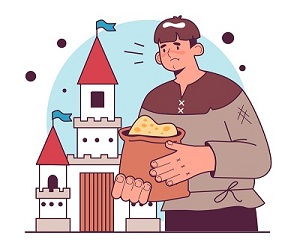

Feudalism was a social and economic system in European countries in the Medieval period between the 5th to 12th centuries.  It was a hierarchy of distribution of fief, i.e. a portion of land to vassals. The structure of feudal society is like a pyramid. In this pyramid, the king is at the top, which is followed by the nobles, Barons, Knights, and Peasants at the bottom. Those at the bottom have to pay taxes to overlords of the pyramid.
It was a hierarchy of distribution of fief, i.e. a portion of land to vassals. The structure of feudal society is like a pyramid. In this pyramid, the king is at the top, which is followed by the nobles, Barons, Knights, and Peasants at the bottom. Those at the bottom have to pay taxes to overlords of the pyramid.
“Feudalism”, or “Feudal system” comes from the Latin word “feudum” which means “fief” i.e. a portion of land and feodalitas means services connected to a fief. In simple words, it refers to holding property or land tenure. It was a significant aspect of social, economic and political life in the medieval period.
Apart from King, Nobles and the church had the privilege to stay in castles and have their grounds. They enjoy the Homage from their vassals. The system stays for centuries. The upcoming generation enjoyed the privilege of taking birth into noble families, as the son of the noble automatically becomes noble.
In this system, the political units were divided into a hierarchy of graded organisation in which every person was allotted a position i.e. King, Nobles/ churches, Barons, Knights, and Peasants.
At that time, the land was the source of power. It was a rural system, in which a portion of land was given by the King to Nobles, nobles give it to barons, and barons to knights and ultimately to peasants or serfs.
These are all known as lords above peasants and the tenant of land as vassals.
No one in the hierarchy owns the land, they have to pay homage to their overlords. The king is only the owner of the fief.
Nobles, barons, and knights give military service to the King in exchange for tax and protect the kingdom.
Peasants gave taxes, and crops to their lords and also fight in times of war.
The main conflict between Nobles and Peasants in the medieval age was status and violence. The peasant's status becomes hereditary, and the son of the peasant becomes a peasant. The serfs were working without any monetary benefits. They are not allowed to join other nobles or lords. If any serf does that, they were killed. The serfs or peasants have to pay taxes and crops to their lords. Even the peasants don’t have ownership of the lands they work.
In England, several political changes decrease the feudalism during 12th and 13th centuries. A legal agreement named Magna Carta was formed that decreased the powers of the king and enhances the entitlement of nobles, and enhances individual rights that lead to a decrease in feudalism.
The violence of nobles increased over vassals and peasants. They are the ones after the king who has ownership of lands. Their Draconian increased in the feudal system, even though the king doesn’t have much control over them. They collect homage from vassals and used their military powers, to make profits by looting and huge taxes. Nobles have limited the rights of the King.
There are a few causes of the decline of Feudalism. These are;
In 1340, the bubonic plague killed many people in Europe, which lead to rebellion against lords. This led to a shift in the powers of nobles to common people.
Reforms and 100 years of war Between France and England (from 1337 to 1453) transfer the powers from lords to monarchs and laymen.
Cultural Interaction decreases the importance of castles and lords.
The hierarchical system of feudalism was challenged, and the common people get more impact over the lords.
More trade routes were opened in Europe, which also opened new opportunities for people to earn money.
Lords break the loyalty towards the king. They became owners of multiple estates, and vassals became tenants of various fiefs. This increases loyalty issues.
In 1300, the pandemic bubonic plague scrape across Asia and Europe. That affected all the people, rich or poor. Many people died due to this disease within a few days. Only a few peasants remained, who started charging the monetary value of their work and freed themselves from the peasantry. This led to a decline in the feudal system of Europe.
Another reason was 100 years of war between England and France also declined feudalism in Europe.
Feudalism was a social, political and economic system in Europe during the Medieval Period since the 5th to 12th centuries. In this system, the king and his noble granted fief to vassals for crop production. In return, the vassals have to pay Homage to their overlords. The knights have peasants that work unfree for that fief and pay taxes and crops to them, and also give military help to their lords. Feudalism starts declining after the cultural, political, social, environmental and economic changes in Europe.
Q1. What led to the end of feudalism?
Ans. The French Revolution changes the constitutional monarchy and bring changes in the feudal system. This led to the end of feudalism.
Q2. Who started the rebellion against lords or nobles in Europe?
Ans. “Wat Tyler” was a peasant in England who started the revolt against Lord John Bampton in 1381. John Bompton charges unpaid “Poll Taxes”, which causes rebellions among peasants.
Q3. Who are vassals?
Ans. Lords give fiefs to a person, who cultivates the fiefs with the help of serfs. These persons are known as Vassals.